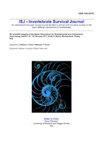综合下水道和城市污水对淡水贻贝的长期和比较影响
IF 1.2
4区 农林科学
Q4 IMMUNOLOGY
引用次数: 3
摘要
过量的降雨事件可能导致溢流和下水道合流,这可能威胁到当地的贻贝种群。本研究旨在比较合并式污水溢出和处理过的城市污水对笼型平纹贻贝的长期影响。贻贝在两个溢流地点、一个主要城市污水扩散羽流的下游地点和一个参考上游地点进行了为期3个月的笼捕。在暴露期结束时,收集贻贝,分析城市污染物(包括药物),以及基于内分泌干扰(卵黄原蛋白表达),外源解毒(谷胱甘肽s -转移酶和金属硫蛋白),氧化应激/炎症(环氧化酶和脂质过氧化)和DNA损伤的生物标志物的影响。数据显示,地表水的药品含量低于下游地区,但阿特拉津及其代谢物在溢流地区的含量较高。贻贝在下游的总异养细菌、咖啡因、乙酰丁醇和文拉法辛的含量高于上游,其中一个溢出点的咖啡因含量较高。仅在下游圈养的贻贝中,卵黄原蛋白基因表达水平在两性中均显著升高。多变量分析表明,生物标志物响应在上游、溢流和下游完全分离。根据卵黄原蛋白、金属硫蛋白、性腺和消化腺DNA损伤、性腺脂质/蛋白储备、脂质过氧化、性腺-体指数和条件因子进行位点识别。使用幂律方法进行的不良结果通路分析显示,通过判别功能分析确定的生物标志物的大多数变化与性腺能量储备、组织/贻贝大小和空气应激后体重减轻有关。综上所述,在溢流点圈养的贻贝的毒性效应通常低于在处理过的城市污水下游圈养的贻贝,这表明这些溢流比持续暴露在处理过的城市污水中造成的风险更低。本文章由计算机程序翻译,如有差异,请以英文原文为准。
Long-term and comparative impacts of combined sewers and municipal effluents to freshwater mussels
Excess rainfall events could lead to overflows and combined sewer overflows, which could threaten local mussel populations. This study sought to compare the long- term effects of combined sewer overflows and treated municipal effluents in caged Elliptio complanata mussels. Mussels were caged at 2 overflow sites, one downstream site of a major municipal effluent dispersion plume and a reference upstream site for 3 months during the summer. At the end of the exposure period, mussels were collected, analyzed for municipal contaminants (including pharmaceuticals), and effects biomarkers based on endocrine disruption (vitellogenin expression), xenobiotic detoxification (glutathione S-transferase and metallothioneins), oxidative stress/inflammation (cyclooxygenase and lipid peroxidation) and DNA damage. The data revealed that surface waters contained less pharmaceutical products than the downstream site but atrazine and its metabolite were at higher levels in overflow sites. Mussels contained elevated amounts of total heterotrophic bacteria, caffeine, acebutolol and venlafaxine at the downstream site relative to the upstream site where caffeine was higher at one of the overflow site. The levels of vitellogenin gene expression were significantly increased in both sexes of mussels caged at the downstream site only. Multivariate analysis revealed that the biomarker responses were completely separated between upstream, overflow and downstream sites. The site discrimination was based on vitellogenin, metallothioneins, DNA damage in gonad and digestive gland, gonad lipids/proteins reserves, lipid peroxidation, gonado-somatic index and condition factor. Adverse outcome pathways analysis using the power law approach revealed that most changes in the biomarkers identified by discriminant function analysis were significantly scaled to gonad energy reserves, tissue/ mussel size and loss of weight following air emersion stress. In conclusion, the toxic effects of mussels caged at overflow sites generally displayed lower responses than mussels caged downstream a treated municipal effluent suggesting that these overflows pose a lower risk than the continuous exposure to treated municipal effluent.
求助全文
通过发布文献求助,成功后即可免费获取论文全文。
去求助
来源期刊

ISJ-Invertebrate Survival Journal
IMMUNOLOGY-ZOOLOGY
CiteScore
2.10
自引率
0.00%
发文量
0
审稿时长
>12 weeks
期刊介绍:
Invertebrate Survival Journal (ISJ) is an international and open access journal devoted to prompt and innovative studies on the basic defense mechanisms in invertebrates, in particular with a view to identifying biotechnologies able to act against derived diseases and related economic damage.
Contributions will be mainly in the form of Letters to the Editor, Visions and Perspectives, Short Communications, Technical Reports, Research Reports, Review, Minireview and Reports of Meetings. Letters to the Editor can be commentaries or perspectives on invertebrate defence mechanisms or replies to the data published in ISJ.
 求助内容:
求助内容: 应助结果提醒方式:
应助结果提醒方式:


